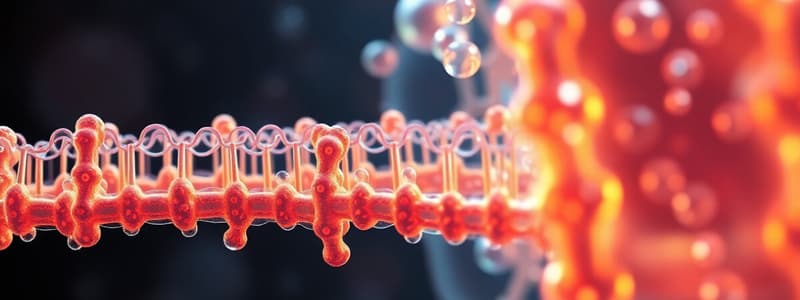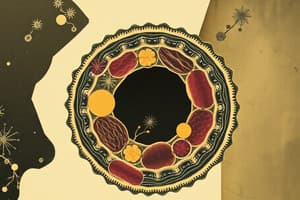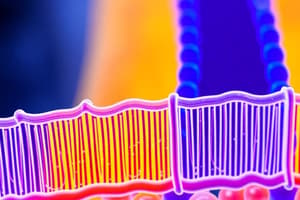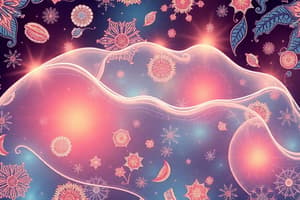Podcast
Questions and Answers
What is the primary type of movement that phospholipids perform within the same monolayer of a cell membrane?
What is the primary type of movement that phospholipids perform within the same monolayer of a cell membrane?
- Lateral diffusion (correct)
- Hyper-rotation
- Cyclic movement
- Flip-flop movement
Which of the following factors does NOT affect the fluidity of the cell membrane?
Which of the following factors does NOT affect the fluidity of the cell membrane?
- Temperature
- Size of cell organelles (correct)
- Chemical structure of phospholipid tail
- Presence of cholesterol
What rare event occurs when phospholipids move from one monolayer of the membrane to another?
What rare event occurs when phospholipids move from one monolayer of the membrane to another?
- Translocation
- Flip-flop movement (correct)
- Lateral diffusion
- Cis-trans isomerization
What aspect of the phospholipid tails primarily influences their ability to pack tightly and affect membrane fluidity?
What aspect of the phospholipid tails primarily influences their ability to pack tightly and affect membrane fluidity?
What kind of movements do lipid molecules flex their hydrocarbon tails and rotate around?
What kind of movements do lipid molecules flex their hydrocarbon tails and rotate around?
What is the primary role of phospholipids in the cell membrane?
What is the primary role of phospholipids in the cell membrane?
Which of the following correctly describes the composition of the cell membrane?
Which of the following correctly describes the composition of the cell membrane?
How are the hydrophilic heads and hydrophobic tails of phospholipids arranged in the lipid bilayer?
How are the hydrophilic heads and hydrophobic tails of phospholipids arranged in the lipid bilayer?
Which factor contributes to the fluidity of the cell membrane?
Which factor contributes to the fluidity of the cell membrane?
Which of the following correctly describes cellular organelle membranes?
Which of the following correctly describes cellular organelle membranes?
What is a key function of carbohydrates in the cell membrane?
What is a key function of carbohydrates in the cell membrane?
Which type of molecule is primarily responsible for embedding in the cell membrane and performing various functions?
Which type of molecule is primarily responsible for embedding in the cell membrane and performing various functions?
What effect do lipid bilayer structures have on molecule permeability?
What effect do lipid bilayer structures have on molecule permeability?
What governs the opening and closing of ion channels?
What governs the opening and closing of ion channels?
What is the primary function of transporters in cell membranes?
What is the primary function of transporters in cell membranes?
What type of channel opens in response to binding by a ligand?
What type of channel opens in response to binding by a ligand?
Which ions are typically found in higher concentrations outside of the cell compared to the inside?
Which ions are typically found in higher concentrations outside of the cell compared to the inside?
What characterizes resting membrane potential?
What characterizes resting membrane potential?
What drives the movement of molecules across a membrane during passive transport?
What drives the movement of molecules across a membrane during passive transport?
Where do mechanically-gated channels primarily function?
Where do mechanically-gated channels primarily function?
What happens when diffusion reaches equilibrium across a membrane?
What happens when diffusion reaches equilibrium across a membrane?
What mechanism do voltage-gated channels rely on for their activation?
What mechanism do voltage-gated channels rely on for their activation?
Which of the following is NOT a type of transport protein?
Which of the following is NOT a type of transport protein?
What characteristic of small non-polar molecules allows them to undergo simple diffusion across the lipid bilayer?
What characteristic of small non-polar molecules allows them to undergo simple diffusion across the lipid bilayer?
Which factor does NOT influence the direction of passive transport for charged molecules?
Which factor does NOT influence the direction of passive transport for charged molecules?
Facilitated diffusion is primarily used for which type of molecules?
Facilitated diffusion is primarily used for which type of molecules?
What type of transport involves moving molecules from low to high concentration against a gradient?
What type of transport involves moving molecules from low to high concentration against a gradient?
How do aquaporins facilitate the movement of water?
How do aquaporins facilitate the movement of water?
In which direction do water molecules move during osmosis?
In which direction do water molecules move during osmosis?
Which statement best describes the electrochemical gradient?
Which statement best describes the electrochemical gradient?
What type of molecules benefit from facilitated diffusion?
What type of molecules benefit from facilitated diffusion?
Which statement is true regarding sodium (Na+) and potassium (K+) transport across the membrane?
Which statement is true regarding sodium (Na+) and potassium (K+) transport across the membrane?
What is the primary requirement for active transport mechanisms?
What is the primary requirement for active transport mechanisms?
What is the effect of high temperature on the movement of phospholipids in the cell membrane?
What is the effect of high temperature on the movement of phospholipids in the cell membrane?
Which type of fatty acid is characterized by having only single bonds between carbon atoms?
Which type of fatty acid is characterized by having only single bonds between carbon atoms?
What role does cholesterol play in membrane fluidity at low temperatures?
What role does cholesterol play in membrane fluidity at low temperatures?
How do unsaturated fatty acids affect the fluidity of cell membranes?
How do unsaturated fatty acids affect the fluidity of cell membranes?
What is the primary function of integral membrane proteins?
What is the primary function of integral membrane proteins?
What type of interaction helps maintain membrane fluidity at varying temperatures?
What type of interaction helps maintain membrane fluidity at varying temperatures?
Which part of the lipid bilayer primarily prevents hydrophilic molecules from passing easily?
Which part of the lipid bilayer primarily prevents hydrophilic molecules from passing easily?
What characteristic do trans-unsaturated fatty acids have?
What characteristic do trans-unsaturated fatty acids have?
Why are membrane carbohydrates important?
Why are membrane carbohydrates important?
How does the length of hydrocarbon tails affect membrane fluidity?
How does the length of hydrocarbon tails affect membrane fluidity?
What is a primary function of membrane transport proteins?
What is a primary function of membrane transport proteins?
Why are peripheral proteins different from integral proteins?
Why are peripheral proteins different from integral proteins?
What does the term 'fluid mosaic model' refer to in relation to the cell membrane?
What does the term 'fluid mosaic model' refer to in relation to the cell membrane?
Flashcards
Cell membrane structure
Cell membrane structure
A protective layer around all cells, composed of lipids, proteins, and carbohydrates.
Lipid bilayer
Lipid bilayer
Two layers of phospholipids and cholesterol forming the cell membrane's core.
Membrane fluidity
Membrane fluidity
The ability of membrane lipids and proteins to move freely within the cell membrane.
Phospholipid structure
Phospholipid structure
Signup and view all the flashcards
Cell membrane composition
Cell membrane composition
Signup and view all the flashcards
Hydrophilic head
Hydrophilic head
Signup and view all the flashcards
Hydrophobic tail
Hydrophobic tail
Signup and view all the flashcards
Organelle membranes
Organelle membranes
Signup and view all the flashcards
Lateral diffusion
Lateral diffusion
Signup and view all the flashcards
Flip-flop
Flip-flop
Signup and view all the flashcards
Hydrocarbon tail flexion
Hydrocarbon tail flexion
Signup and view all the flashcards
Hydrocarbon tail rotation
Hydrocarbon tail rotation
Signup and view all the flashcards
Factors affecting membrane fluidity
Factors affecting membrane fluidity
Signup and view all the flashcards
Channels (Membrane Transport)
Channels (Membrane Transport)
Signup and view all the flashcards
Transporters (Membrane Transport)
Transporters (Membrane Transport)
Signup and view all the flashcards
Open vs. Closed Channels
Open vs. Closed Channels
Signup and view all the flashcards
Voltage-Gated Channels
Voltage-Gated Channels
Signup and view all the flashcards
Ligand-Gated Channels
Ligand-Gated Channels
Signup and view all the flashcards
Mechanically-Gated Channels
Mechanically-Gated Channels
Signup and view all the flashcards
Resting Membrane Potential
Resting Membrane Potential
Signup and view all the flashcards
Concentration Gradient
Concentration Gradient
Signup and view all the flashcards
Passive Transport
Passive Transport
Signup and view all the flashcards
Simple Diffusion vs. Facilitated Diffusion
Simple Diffusion vs. Facilitated Diffusion
Signup and view all the flashcards
Effect of Temperature on Cell Membrane Fluidity
Effect of Temperature on Cell Membrane Fluidity
Signup and view all the flashcards
Saturated Fatty Acids
Saturated Fatty Acids
Signup and view all the flashcards
Unsaturated Fatty Acids
Unsaturated Fatty Acids
Signup and view all the flashcards
Cis-unsaturated Fatty Acids
Cis-unsaturated Fatty Acids
Signup and view all the flashcards
Trans-unsaturated Fatty Acids
Trans-unsaturated Fatty Acids
Signup and view all the flashcards
Phospholipid Tails
Phospholipid Tails
Signup and view all the flashcards
Cholesterol's Effect on Fluidity
Cholesterol's Effect on Fluidity
Signup and view all the flashcards
Membrane Proteins (Integral)
Membrane Proteins (Integral)
Signup and view all the flashcards
Membrane Proteins (Peripheral)
Membrane Proteins (Peripheral)
Signup and view all the flashcards
Membrane Protein Functions
Membrane Protein Functions
Signup and view all the flashcards
Semi-permeable Membrane
Semi-permeable Membrane
Signup and view all the flashcards
Transport Proteins
Transport Proteins
Signup and view all the flashcards
Glycoproteins
Glycoproteins
Signup and view all the flashcards
Glycolipids
Glycolipids
Signup and view all the flashcards
Simple Diffusion
Simple Diffusion
Signup and view all the flashcards
Facilitated Diffusion
Facilitated Diffusion
Signup and view all the flashcards
Electrochemical Gradient
Electrochemical Gradient
Signup and view all the flashcards
What are pumps?
What are pumps?
Signup and view all the flashcards
Osmosis
Osmosis
Signup and view all the flashcards
Aquaporins
Aquaporins
Signup and view all the flashcards
Osmolarity
Osmolarity
Signup and view all the flashcards
Study Notes
Cell Membrane Structure and Transport
- The cell membrane is a protective layer surrounding all cells
- It's composed of lipids, proteins, and carbohydrates
- The membrane is selectively permeable, allowing some molecules to pass through but not others
Cell Membrane Composition
- Lipids (40%):
- Phospholipids and cholesterol form a bilayer
- Proteins (50%):
- Embedded in the bilayer, performing various functions
- Carbohydrates (10%):
- Attached to proteins (glycoproteins) and lipids (glycolipids)
- Extend out of the membrane surface
Organelle Membranes
- Intracellular organelles have membranes too
- These membranes have similar lipid bilayer structures, but slightly different compositions than the cell membrane
- Nucleus and mitochondria have two lipid bilayers. Other organelles like ER, Golgi, and lysosomes have one.
Lipid Bilayer Structure
- Phospholipids have hydrophilic heads and hydrophobic tails
- Hydrophilic heads interact with water, while hydrophobic tails cluster together, forming a bilayer
Phospholipids and Cholesterol
- Phospholipids have a polar head (hydrophilic) and nonpolar tails (hydrophobic).
- Cholesterol is interspersed within the bilayer, modulating fluidity.
Cell Membrane Lipid Bilayer
- Membrane lipids are exposed to two opposing forces: attraction to water (hydrophilic heads) and repulsion from water (hydrophobic tails).
- The bilayer forms due to these forces, with hydrophilic heads facing water on both surfaces, and hydrophobic tails clustered within the bilayer's interior
Cell Membrane Fluidity
- Membrane lipids and proteins can move freely within the membrane
- This movement creates a fluid structure
Cell Membrane Phospholipid Movement
- Phospholipids move and change positions within the same monolayer (lateral diffusion)
- This movement is catalyzed by enzymes
- Lipid molecules rarely move from one monolayer to the other (flip-flop)
- Fluidity depends on the tightness of packing of hydrocarbon tails
Factors Determining Cell Membrane Fluidity
- Temperature: Increased temperature increases fluidity, decreasing temperature decreases it.
- Chemical structure of phospholipid tails: Unsaturated phospholipids increase fluidity while saturated phospholipids decrease fluidity
- Cholesterol levels: Cholesterol acts as a buffer, maintaining fluidity at both high and low temperatures
Effect of Temperature on Cell Membrane Fluidity
- High temperatures: Increased energy allows more movement between phospholipids - thus increasing fluidity
- Low temperatures: Decreased energy results in less movement, tighter packing, and decreased fluidity.
Saturated vs Unsaturated Fatty Acids
- Saturated fatty acids have only single bonds between their carbon atoms, resulting in a straight, tightly packed structure at room temperature.
- Unsaturated fatty acids have one or more double bonds between carbon atoms, leading to bent structures and a lower packing density; more liquid-like at room temperature
Phospholipid tails
- Consist of two fatty acid tails
- Can be saturated or unsaturated
Effect of Phospholipid Structure on Cell Membrane Fluidity
- Length of hydrocarbon chains:
- Shorter hydrocarbon tails less interact with each other, which increases fluidity
- Double bonds:
- Hydrocarbon tails with double bonds are bent, increasing the space between hydrocarbon tails and increasing fluidity.
Effect of Cholesterol on Cell Membrane Fluidity
- Cholesterol fits in the spaces between phospholipid molecules and regulates membrane fluidity.
- Acts as a buffer to prevent extreme changes in membrane fluidity at both low and high temperatures
Importance of Cell Membrane Fluidity
- Allows cells to adapt their shape and movement to different conditions
- Enables membrane proteins to diffuse and interact with each other for cell signaling
- Ensures membrane molecules are evenly distributed between daughter cells during cell division
- Allows membranes to fuse together
Membrane Proteins and Carbohydrates
- Proteins are embedded within the membrane (integral proteins) or attached to its surface (peripheral proteins)
- Carbohydrates are attached to proteins and lipids on the cell's surface, forming glycoproteins and glycolipids.
Membrane Protein Functions
- Transporters:
- Move ions and macromolecules in and out the cell
- Receptors: Detect chemical signals from the environment
- Enzymes: Catalyze chemical reactions
- Anchors: Connect the cell membrane to the cytoskeleton
Membrane Carbohydrates
- Some membrane lipids have sugars attached (glycolipids).
- Many proteins also have sugars attached (glycoproteins).
- Polysaccharides in chains form proteoglycans.
- Important for protection, lubrication, and cell-cell recognition
Membrane Transport Proteins
- Membrane transport proteins are needed in cells to allow the passage of certain hydrophilic molecules
- Channels allow particular ions to pass based on size and charge
- Transporters move molecules, which fit in specific areas of the protein (similar to enzyme-substrate binding)
The Cell Membrane is Semi-permeable
- The hydrophobic interior of the lipid bilayer prevents the passage of most hydrophilic molecules.
- The lipid bilayer is selective:
- Small, non-polar molecules cross rapidly (e.g., O2, CO2, N2, steroid hormones)
- Small polar molecules cross slowly (e.g., H2O, ethanol)
- Large polar molecules and ions require transporter proteins
Transport Proteins
- Cells and organelles need transport proteins to move hydrophilic molecules across membranes.
- Examples of transport proteins include channels and transporters
Types of Ion Channels
- Voltage-gated channels open in response to membrane potential changes.
- Ligand-gated channels open when a molecule binds to them (such as neurotransmitters at synapses)
- Mechanically-gated channels open in response to mechanical forces (like auditory hair cells)
Resting Membrane Potential
- The cell membrane is not permeable to ions
- Differences in ion concentrations inside and outside the cell create a voltage difference (resting membrane potential)
- The inside of the cell is usually slightly more negative than outside.
Mechanisms for Membrane Transport:
- Concentration Gradient: The difference in concentration of a substance across a membrane.
- Diffusion: Molecules move from high to low concentration.
- Passive Transport:
- Simple Diffusion: Small, nonpolar molecules cross the lipid bilayer directly
- Facilitated Diffusion: Large, polar molecules use transporter proteins to cross.
- Active Transport:
- Molecules move against their concentration gradient, requiring energy (ATP).
Osmosis
- Crucial for water movement into and out of cells
- Water moves from areas of low solute concentration to high solute concentration
- This process is facilitated by aquaporins
Studying That Suits You
Use AI to generate personalized quizzes and flashcards to suit your learning preferences.




